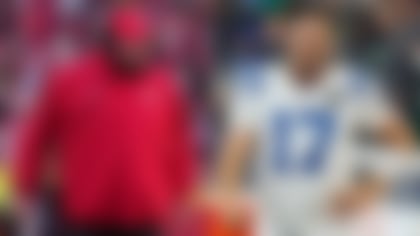The image of Thomas Dimitroff, as the NFL shook in the wake of his move 21 spots up the draft board last week, was appropriate.
The Falcons' general manager threw his arms behind his head, leaned back in his swivel chair, and waited for the announcement that his organization had its man: Alabama dynamo Julio Jones.
As the shock washed over the public -- as the television graphics took down Cleveland's orange and brown and indicated that the 13-3 Falcons (Who?!? Wait, What?!?) were on the clock with the sixth overall pick -- Dimitroff was at peace, taking in six weeks of work and research. All of his nerves were settled and the job done.
Championship on their minds
The Falcons finished an NFC-best 13-3 last year and are hungry for a Super Bowl, which is why they moved up 21 spots to draft receiver Julio Jones, writes Steve Wyche. **More...**
» Lombardi:Like what the Browns got
This move might have smacked of a knee-jerk, George Steinbrenner, ball-up-your-resources-and-throw-them-at-a-problem maneuver, but this was every bit as calculated, in research and execution, as the drafting of Matt Ryan was three years ago. And that's why the sense at the end for the fourth-year GM was one of relief -- that he, coach Mike Smith and owner Arthur Blank had pulled this one off, after all the work they'd put in.
"This was an aggressive, bold move for us, one that wouldn't have been right for us two years ago, and might not be right for us two or three years from now," Dimitroff said on Wednesday afternoon, six days after pulling it off. "This was the time. We truly felt like, at this point, it was right for us to make a bold move, based on where our roster is, the age of our roster, the development of talent on our roster.
"For me as a GM, Smitty as a coach, and Mr. Blank as owner, there's an understanding we're making a very strong decision, and it's significant in compensation."
How strong and how significant?
Consider this: There was only one trade involving a top-six pick from 2005-10, and that one involved a quarterback. The Jets, moving up 12 spots to get Mark Sanchez fifth overall in 2009, paid what seemed like a heavy freight to the Browns to do it. They gave up the 17th pick (Josh Freeman went in that slot to Tampa Bay after another Cleveland trade), the 52nd pick (LB David Veikune), and veterans Brett Ratliff, Kenyon Coleman and Abe Elam.
The Browns' haul from the deal wound up being Veikune, Ratliff, Coleman, Elam, Alex Mack, Coye Francies, and James Davis. Mack made his first Pro Bowl in 2009 and looks like an anchor for the Browns' line for years to come. Elam is a starter. Veikune, Ratliff, Francies, and Davis were all cut in 2010. And Coleman was released in February.
That history is important to keep in mind when considering the Falcons' decision-making in 2011. Atlanta gave up two first-rounders (2011, '12), a second-rounder this year, and two fourth-rounders (2011, '12). But from the Atlanta brass' view, it really boiled down to the second-rounder this year and the first-rounder next year. This year's first was simply being upgraded, and the health of the guts of the roster -- which Dimitroff and Co. spent three years fortifying (hence: timing) -- made the fourth-rounders expendable.
So with the knowledge the Falcons have plenty of fourth-round types already on their roster, which Dimitroff is proud of and values, the risk was giving up the chance to select a player like Greg Little (who went to Cleveland in Atlanta's second-round slot) and what they believe will be a late first-rounder next year.
What made Dimitroff swallow hard and do it? The player they were moving up for.
"We weren't looking at it thinking about risks; we weren't making a decision like this with Julio with the concern that this player would bust," Dimitroff said. "That was not even part of discussion, and everyone was part of this decision. Nobody in our organization feared bust or even mediocrity with Julio. It was never a concern. If there was a concern, it was more in line with, 'OK, how do we approach this? How do we get our heads around a two this year and, most importantly, the one next year.'
"That was the discussion. In the end we concluded this wouldn't have been right two years ago. Maybe it won't be right two years from now, but where the roster is now, combined with the number of veterans we have at a later point in their careers, we feel it was worth the compensation."
There's an implicit message in there, too, that the Falcons see Jones as a player ready to contribute now, which surely is helped along by the pro style of offense in which he played at Alabama.
NFC South draft grades
Now that the Falcons have made a big trade to get Matt Ryan another weapon, have they put themselves in position to repeat as division champs? Bucky Brooks examines. **More...**
But there's also something deeper. Learning about Jones as a person, given the investment Atlanta made in him and also in building a locker room culture under Smith, was vital. And while Dimitroff will remind you over and over again that Jones is coming in as a playmaker, his blocking might say as much about Jones as a football player as anything.
In fact, in one pre-draft meeting with Jones, offensive coordinator Mike Mularkey played some tape and asked him about his willingness to crack back on a defensive back. Jones responded: "Not only will I crack back, I'll kill this DB." That, to Mularkey and receivers coach Terry Robiskie, was all they needed to hear, not only showing Jones' competitiveness and team ethos, but also beliefs that aligned with their own.
The exhaustive work of Dimitroff's trusted personnel directors -- Les Snead, Lionel Vital and David Caldwell -- and coaches got them there, where the consideration of moving up was in play. But they needed Jones, as a person, to put them over the top. And Jones did that.
"We were comfortable with the combination of skill, big-play ability, size, and speed, but we also talked about how he'd fit in, given his stature, aggressive style, that he played in a very successful program under arguably the best coaches," Dimitroff said. "And a comment that Nick Saban made to me stuck. He said, 'This player, unlike any other player I've had, is not easily affected.'
"What that means is he will not be enthralled with coming to the NFL, or moved by the idea that he's coming in after we traded up. That was very important."
And all that is why, last Thursday night, Dimitroff couldn't have looked more comfortable if he was at home on a day off with the clicker in one hand and a Heineken in the other. The work was done, and there had been a lot of it. The time for fretting? All that was over.
As far back as the middle of last season, the Falcons recognized their need for another stick of dynamite in their offense. The vision of how the Indianapolis Colts used to score at will in the heyday of Marvin Harrison and Reggie Wayne came to mind, as did the notion of how much having another bona-fide, defense-altering weapon would help Roddy White.
Could White and Jones be to Matt Ryan what Harrison and Wayne were to Peyton Manning? The idea is why it took six weeks of research and huddling between Blank, Dimitroff and Smith to get there. And it's why the answers came back affirmative.
"This is not the type of decision that's just coming off the pounding of the fist on the table by the GM," Dimitroff said. "This is an organizational decision. This was synonymous with the research we did, at so many levels, when we drafted Matt Ryan. It was a big organizational decision, and it took a lot of time."
It'll take more time, of course, to figure out whether it was the right move or not. But what's already crystal clear is the resolve Dimitroff and his people had in making the move.
Follow Albert Breer on Twitter @AlbertBreer











